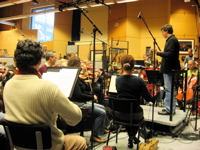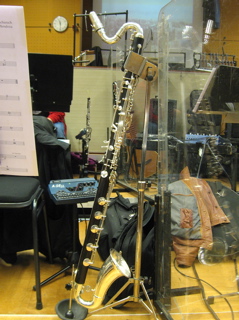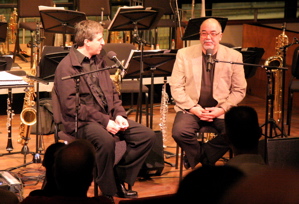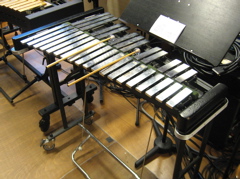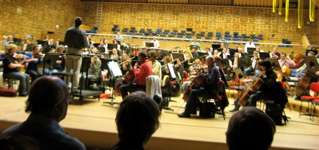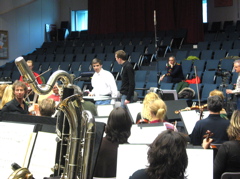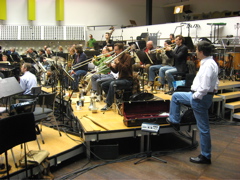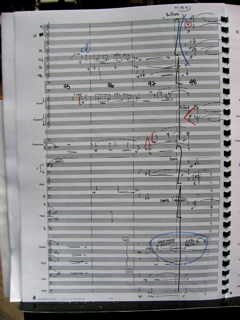Homepage > Documents > Musician Interview
Metropole Orkest musician interview with composer, arranger and conductor Vince Mendoza
"Arranging is a fun endeavour!"
Interviewing Vince Mendoza about composing and arranging
Picture yourself in a dark brown leather armchair in front of a burning fireplace, and 'Grandmaster V' willing to reveal the mystery of musical creativity. Well, that's the setting for the interview with Vince Mendoza, Chief Conductor of the Metropole Orchestra (MO), about composing and arranging.
Arranging technique
As an answer to the opening question about arranging specifics, Vince Mendoza starts by remarking: "Well, first of all, when you're talking about arranging, you are also talking about composing. Arrangers are by virtue of their activities, like composers, thinking about melodic material, musical architecture and sound. They are responsible for what the musical personality of a group is; how they are recognisable as a particular type of ensemble. For example, we know the personality of the Frank Sinatra middle period with Nelson Riddle, the Fletcher Henderson or Basie Band, the Ellington - Strayhorn combination, or Quincy Jones's work on Thriller for Michael Jackson, the 1970s Philadelphia sound, etc. The arranger is the architect of the personality. There is a certain amount of craft involved in it, but he has to take many artistic decisions like a composer does. Arranging is also an art."
As to the required craftsmanship of the arranger, Vince Mendoza elucidates: "His skill set must include orchestration, knowledge of the group that he is writing for in the context of the style. With regard to the MO it is a mixed bag of tricks, because there are so many styles associated with their activities. That's why we use a lot of arrangers, depending on the programme: world music, (contemporary) jazz or pop music. Even within the pop music there is a wide range. Remember last year, we did both the Gothic rock, the Burt Bacharach and Dutch cabaret project.
Writing for the MO, I use the traditional, classical orchestration approach. I consider them a small symphony orchestra with a rhythm group, with a wide range of possibilities. The big band approach on the other hand is stylistically most specific; arranging course books will steer you towards a specific way of writing for the instruments. People with a genuine big band background have a better grasp on the more traditional jazz projects with this orchestra. My own projects with the orchestra are more contemporary, sometimes quasi-classical things, world and pop music, because there I am more able to exercise my skill set and my language."
About voicing, Vince Mendoza states: "When students ask me about voicing in the woodwind or brass section, I shy away from talking about those issues. Giving ideas of specific voicings evokes stylistic reference. It is so much of a personal style element. There is the immediately recognizable brass section writing of Sammy Nestico for the Basie band, or tutti chord voicing in Mahler symphonies, or the Duke Ellington woodwind section. You really have to figure out for yourself, what you want to do with regard to the voicing for any section; the things that you can think about are register, density in a cluster, how an instrument will sound and then the voice leading. Voicing cannot be generalized."
About his working procedure he reveals: "Everybody has their own process, as to what inspires them the most. I am perfectly capable of orchestrating on the bus, although these days I don't take the bus anymore. But, when working on source material, I need time to be inspired, to get the sound of a piece in my head, mess around with a song at the keyboard, take it apart. I encourage my students to do the same, to create an internal response by first de-composing and then re-composing a piece. With a song I study the lyrics, see what the song is about.
I do not want to write only music that I can play; I use the piano to discover what the language is going to be and what I can do with it. I write my scores in pencil at the desk, before entering them on the computer in music notation software. The computer slows me down, whereas I like 'dancing around', determining the rhythmic and melodic parts at the desk. You know, I cannot tolerate a notation error in the computer score; when I know there is one, I have to go back to find it and correct. But by then I have forgotten what I wanted to write."
How much detail must be marked in the score? Vince Mendoza is most explicit about this issue: "100% necessary. I always tell my students to put in as much dynamic markings, phrasing and accents, as they can. I never write a melody or a counterpoint without adding articulation and dynamics; a score is just not done without those markings. You know, the MO is so broad in their repertoire, and there are many possibilities for interpretation. The musicians like to know, what is being expected from them, and so does the conductor. And in the free-lance context, it saves time during a three-hour recording session. Although as a conductor I make my own judgements and take liberty to apply some changes at the recording, in particular with respect to the dynamics, in order to improve the orchestral balance."
Style elements
Vince Mendoza: "One element of my style is counterpoint. I take great care at voice leading. I ask myself, even in sectional big band writing: where is the 2nd trumpet going in the next chord? Is it moving by step or leap? Just slamming chords on the piano and then pasting them onto the brass section, without voice movement considerations, will ultimately affect the performance. I studied classical, 17th and 18th century counterpoint from the Fux book [Gradus ad Parnassum, a classical textbook about tonal, baroque counterpoint - FA]. I did the exercises for all the species, respecting the rules for preparing and resolving dissonance and voice leading. However, when you strictly apply those rules, you end up with 3rd rate Handel, and, again, you evoke stylistic reference. The same thing happens when you follow the big band sectional harmony writing rules; you end up sounding like the Basie band. If you want to develop your own style, somehow you have to transfer those concepts to music to the year 2009. Strawinsky and Boulez scores teach you a lot about intervallic relations, tension and release. My counterpoint is based on balancing consonance and dissonance. However, when working on a songbook standard, tonality must be respected, and I will not write intervallic music. Unless someone specifically wanted an atonal version of Stella by Starlight, but I have not had any request for that lately.
I apply frequent independent voice leading in string section textures; even when it is playing ostensibly chords from somebody else, there is still movement inside the section. It gives the player direction; even though they may be playing an accompaniment, they will have an expressive part. However, unless all the voices were moving in a particular rhythmic pattern, it is not meant to suggest a groove; if the rhythm section is playing something funky, then to have the string section moving in an un-funky manner will be very unsatisfying."
Instrumentation aspects
When the discussion turns to the specifics of writing for the MO or any other studio orchestra, Vince Mendoza comments: "Well, the studio orchestra came about with the desire to mix the popular big band element with the sound of strings. This was happening in the 1940s and 1950s. The Sinatra - Dorsey combination was basically a big band approach, with studio strings in the background 'sawing away' their whole notes. Until arrangers like Gordon Jenkins came along, with a more orchestral approach; a mixed ensemble approach to writing, with counterpoint in the strings. The MO size and functioning dates back to that period, and hasn't changed much since the days of Dolf van der Linden. It would be great to have a permanent set of 4 French horn players; that would really counterbalance the big band brass section. Currently, that only happens occasionally, for example in the recent TROS film music programme. I treat the single French horn more as a member of the woodwind section. But no matter the number of horns, they would always be seated behind the winds, stage-right, with their bells pointing away from the stage. That helps the sound projection and there are audio recording considerations as well. Another great thing would be the addition of a pair of bassoons; both as a bottom extension to the wind section, but also as an addition to the low brass. Gil Evans has used bassoons to replace 3rd and 4th trombone. And, obviously, the orchestral balance would benefit from adding a significant amount of string players; think of 4 to 6 basses, and 7 to 10 cellos, somewhat similar to the numbers in the Radio Philharmonic Orchestra. That would be amazing. And it is essential in pop music productions with a very strong playing brass and rhythm section."
Vince Mendoza in his productions always adds an extra double bass to the regular two bass players: "Yes, it yields a better bass sound. Remember, one bass player is better than two; you will always hear the two individuals. Use odd numbers." In his music, one will hear frequent use of the string quartet or the cello group as a contrast to the tutti strings. Vince: "I like using the string quartet, the chamber music approach. It changes the perspective of the orchestra, because it puts the focus on the soloists. It is a good orchestration tool to vary the density and texture, although it is a tricky, challenging thing. Due to the seating arrangement, their coordination is limited, compared to the string quartet in an intimate chamber music setting. In the orchestra they may be positioned on opposite sides of the rhythm section, and cannot see each other very well. They may have to rely on headset monitoring, when playing as a quartet. The cello group may play as 4-way divisi, but I will never double their part in any other instrument. In any combination with the big band, you would not hear them, not even with the saxophones. It must remain a chamber music effect. Acoustic balance is still relevant when combining the string section with the big band; amplification is a necessary evil, since it will change the nature of the string sound. Although sometimes there is a pretty good clip microphone set-up, it feels like losing control and I am not satisfied with the sound. I prefer a minimum of sound reinforcement with the natural sound of the symphony orchestra."
And with respect to subtle string techniques, as frequently found in Ravel's scores, his view is: "Except for some world music projects with a specific expressive texture, forget about the string divisi, harmonics, the Bartok pizzicati and the col legno bowing. They are not immediately adaptable to the Metropole Orchestra. Also in world music, there is a soloist, who has to be best served, whose personality has to be respected. Sometimes, when I go in as a conductor and I see arrangements that do not serve the project, I take editorial license and change things on the spot. When the artists come to perform their songs with the orchestra they don't want to hear them transformed into the Rite of Spring."
This brings us to the combination of winds and brass. Vince: "Obviously one does not double a medium range flute part with the brass section; that will also discourage the flute player since he understands how futile the part is. However, the entire woodwind section in the high range with brass will work. Although they usually are sitting on opposite sides of the stage, they can hear each other and will have no problem synchronizing dynamics, articulation and phrasing. And remember, they both hear the rhythm section on the centre stage. Trying the achieve that close synchronization between strings and brass is impossible; it is also the difference between blowing and bowing. With winds and brass the mechanism of sound generation is the same."
Composition
Vince: "I aspire to writing more of my own music, longer pieces, but on the other hand; I like to 'join the party', to meet great musicians and do interesting projects. To share the music with them. That is why I started as a musician playing drums, bass and piano. But you know, arranging is a fun endeavour! In the beginning, I did not anticipate arranging pop songs, since the source material and the original recording are so much fixed in the memory of the singer and the audience. But now I feel enriched by it. Some singers have a strong vision on what their songs are about, and still are open to suggestions. That was the case with Bjork in the Vespertine project. She wanted to take an unconventional course, something with night music and angelic textures. That's when I came up with the choir, a string section, flutes and lots of metallic percussion.
For the Joni Mitchell album Travelogue I had almost complete freedom to determine the instrumentation, which was a huge orchestra. It was a dreamy project. I discussed every song with producer Larry Klein before starting to write. I sent the arrangements and the demos to him and to Joni, before going into the recording studio. A few changes were made along that process. For example, in the studio the chorus parts to Slouching Towards Bethlehem were written last minute upon request. The instrumentation was amazing: note the eight French horns, four trombones, tuba, two bassoons, one counterbassoon. Just great! In the introduction to the song 'Love' the solo trumpet was recorded from the balcony. And then I love the contrast between the huge orchestra and the songs done with a small 10-piece group, such as Otis and Marlena. That was chamber music.
And now, there is a Sting project coming up; he wants a fresh and looser approach to some of his already recorded work. That gives me the freedom to even partly change the form of the songs. However, with a song the arranger must always respect the lyrics; you cannot just throw in eight transitional measures in the middle of a phrase."
In the middle of that phrase the ticking of the fireplace clock triggers another transition. Vince Mendoza has to be off to a next appointment. So folks, that's the end of today's exciting lesson. Let's see what sense I can make of the notes!


